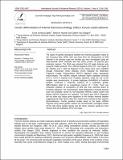Genetic differentiation of Artemia franciscana (Kellogg, 1906) in Kenyan coastal saltworks

View/
Publication Date
2014Author
Erick Ochieng Ogello, Betty M Nyonje and Gilbert Van Stappen (UGent)
Metadata
Show full item recordAbstract/
The nature of genetic divergence between the Artemia population native to San Francisco Bay, (SFB) USA and those from the introductions of SFB material in the Kenyan coast two decades ago were investigated using the mitochondrial DNA (mtDNA) and heat shock protein 70 (Hsp70) gene molecular markers. The DNA was extracted from 80 single Artemia cysts using the Chelex protocol. The 1,500 bp fragment of the 12S - 16S region of the mtDNA and a 1,935 bp fragment of the Hsp70 gene were amplified through Polymerase Chain Reaction (PCR) followed by Restriction Fragment Length Polymorphism (RFLP) digestion using appropriate endonucleases. The mtDNA analysis indicated higher haplotype diversity (0.76 ± 0.07) in Artemia from Fundisha saltworks while the rest of the samples were monomorphic. A private haplotype (AAABBA) in Fundisha samples confirmed a molecular evidence of a systematic genetic differentiation albeit in an insignificant manner (P > 0.05). There was molecular evidence of coexistence of SFB and GSL Artemia strains in Fundisha saltworks. The monomorphic DNA fingerprint in Kensalt Artemia cysts was probably caused by non-sequential Artemia culture system and limited mtDNA fragment size analysed. The Hsp70 gene RFLP fingerprint did not show any unique gene signatures in the Kenyan Artemia samples suggesting that other factors other than Hsp70 were involved in their superior thermotolerance. Further genetical studies based on the larger mtDNA fragment using robust genetic markers are recommended. Ecological studies of the heat shock protein family and the stress response would be more relevant than the qualitative RFLP technique.
